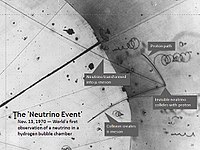
Photo from wikipedia
Neutrinos interact only very weakly, so they are extremely penetrating. The theoretical neutrino–nucleon interaction cross-section, however, increases with increasing neutrino energy, and neutrinos with energies above 40 teraelectronvolts (TeV) are… Click to show full abstract
Neutrinos interact only very weakly, so they are extremely penetrating. The theoretical neutrino–nucleon interaction cross-section, however, increases with increasing neutrino energy, and neutrinos with energies above 40 teraelectronvolts (TeV) are expected to be absorbed as they pass through the Earth. Experimentally, the cross-section has been determined only at the relatively low energies (below 0.4 TeV) that are available at neutrino beams from accelerators. Here we report a measurement of neutrino absorption by the Earth using a sample of 10,784 energetic upward-going neutrino-induced muons. The flux of high-energy neutrinos transiting long paths through the Earth is attenuated compared to a reference sample that follows shorter trajectories. Using a fit to the two-dimensional distribution of muon energy and zenith angle, we determine the neutrino–nucleon interaction cross-section for neutrino energies 6.3–980 TeV, more than an order of magnitude higher than previous measurements. The measured cross-section is about 1.3 times the prediction of the standard model, consistent with the expectations for charged- and neutral-current interactions. We do not observe a large increase in the cross-section with neutrino energy, in contrast with the predictions of some theoretical models, including those invoking more compact spatial dimensions or the production of leptoquarks. This cross-section measurement can be used to set limits on the existence of some hypothesized beyond-standard-model particles, including leptoquarks.
Journal Title: Nature
Year Published: 2017
Link to full text (if available)
Share on Social Media: Sign Up to like & get
recommendations!